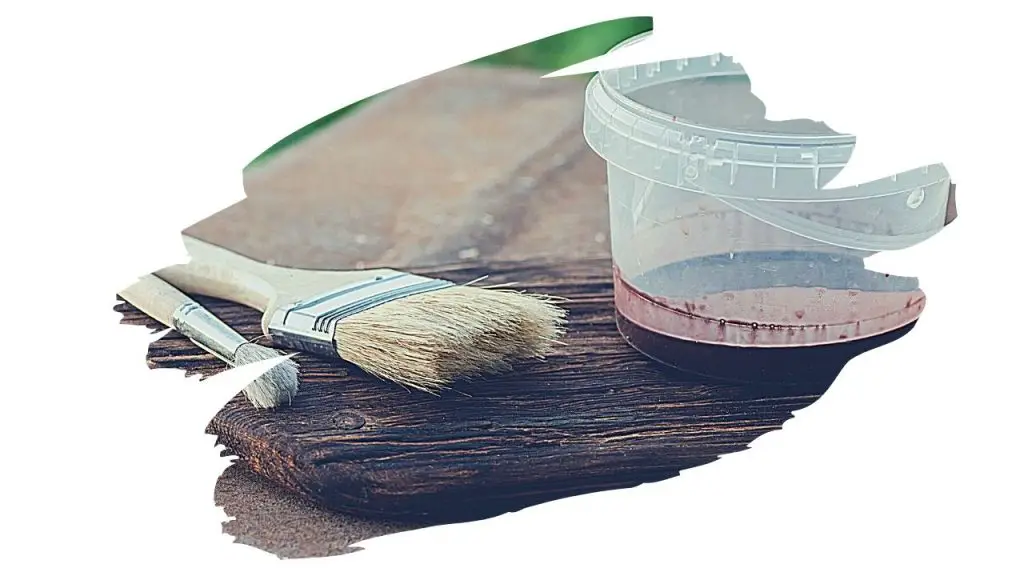One of the best ways to personalize a woodwork project is to give it a bit of colorful flair.
Maybe you want to paint your perfectly made wooden box so that it matches your bedrooms decor.
Or, maybe you simply want to paint your wood craft in your favorite color.
Whatever the reason, you are probably here because you are a little worried about what that paint will do to your Danish oil finished work piece.
So, first things first, can you safely paint over danish oil?
Yes you can paint over Danish oil with oil-based paint, but only if you have given the oil finish time to completely cure.
You also need to make sure that you give the paint a little something to adhere to. You can do this by sanding the surface with very fine grit sandpaper (320 grit) before you begin painting.
So, which types of paint can you use on Danish oil, and which ones should you avoid? Keep reading to find out more…

This post may contain affiliate links to products that we receive a commission for (at no additional cost to you). Learn more here.
Can You Paint Over Oiled Wood In General?
It depends on the type of oil finish. There are two types of popular oil finishes; drying oils and non-drying oils.
Is The Oil Finish A Drying Oil?
If the oil is the type that dries and hardens into a resin, (often referred to as having been ‘cured’), then adding a coat of paint over that oil undercoat isn’t a problem.
Oil finishes such as Danish Oil, Linseed Oil, and Teak Oil fall into this category.
However, painting over drying oil finish comes with one small caveat… you need to first roughen up the finish ever so slightly.
Why? Well, paint will struggle to stay on evenly if it is applied directly onto a very smooth oil finish. So it needs some bits and grit to hang onto (if we want it to adhere to the surface properly). This is why we need to go over the oil finish with fine grit sandpaper first.
Also, the sandpapers grit should be small enough to scuff the surface, but not large enough to scratch it. So something along the lines of 320-grit sandpaper is a good choice.
Is The Oil Finish A Non-Drying Oil?
Some oil finishes don’t dry into a hard resin, instead, they stay on the wood in a sort of ‘damp’ state.
Pure oils such as Mineral oil, (popularly used on wooden items such as Butcher Blocks), doesn’t dry like Danish Oil does.
This odorless oil doesn’t go rancid, and is non-toxic. But, you are going to struggle to get any paint to stay on this wet oil finish.
Can You Paint Acrylic Over Danish Oil?
No, you cannot paint acrylic over Danish Oil. The acrylic paint, (a water-based paint), won’t stick onto oil finishes all that well.
Instead, as the acrylic paint dries, the paint will most likely start to flake and peel off – leaving your woodwork project looking shabby.
Acrylic v Oil Paints (A Quick Guide To Painting Over Danish Oil)
Acrylic Paint
Acrylic paints are water-based, (also referred to as being ‘water-borne’), thanks to the fact that H20 plays a key part in binding the different particles inside this type of paint.
Water-based paints dry very quickly (way faster than oil paints). So if you want to use acrylic paint on danish oil, you should probably opt for putting on a seal coat over the danish oil first.
Afterward, give the seal coat a light sanding, so that you can then paint the acrylic onto the seal coat instead (and not directly onto the danish oil).
Do You Need To Seal Danish Oil First? And What Is A ‘Seal Coat’? Seal coats are quick drying sealers designed to coat and adhere onto most cured clear finishes. You would seal Danish oil first if you plan on painting with acrylic paint. You would then sand the seal coat in preparation for painting. Or you could simply leave it on ‘as-is’ so that it can act as an extra layer of protection.
Related Post: Can You Apply Epoxy Over Danish Oil? (Best Practice Revealed)
Oil Paints
Oil paints are, to put it simply, oil-based. They are made from a blend of linseed oil (typically) and solvents.
They take ages to dry, and usually take up to 6 times longer to dry compared to Acrylic paints.
These types of paint will happily stick to the surface of lightly sanded oil finished woods, so you won’t need to apply a seal coat.
However, it is still very important that you give Danish oil time to dry first, before you start painting.
Paint is one of a range of different top coats that you can put over Danish oil. For example, if you want to give that Danish oil finish a high gloss look, you could try coating it with shellac. Learn more by clicking here to check out our article: Can You Use Shellac To Seal Over A Danish Oil Finish?
How Long Does It Take For Danish Oil To Dry?
Well, for each coat of Danish oil, you will need to give it anywhere between 24 to 48 hours to dry.
And you will need to apply a minimum of 3 coats if you want to ensure a smooth finish.
So, from the moment you apply that very first coat, to the moment the last coat dries, you are looking at anywhere from 3 days up to a week for the Danish Oil to dry.
This of course all depends on you having done the following;
- Wiped away any excess oil between each coat.
- Made sure that the work piece is drying in an area that has low-humidity.
- And making sure that the area has good air-flow and ventilation.
How Can You Tell If Danish Oil Is Dry? You can simply give it a ‘touch test’. Touch the surface of the wood… does it feel dry? If the answer is yes, then it is dry. However, if it feels sticky and tacky to the touch, then it needs more time to cure.
Final Thoughts
So, if you’ve ever wondered whether you can paint onto that Danish oil finish, then there’s nothing stopping you. Just be sure to stick to the following rules of thumb:
- Let It Cure: Always make sure the Danish oil has fully cured and dried before painting.
- Oil Over Oil: Use oil-based paints on oil-based finishes, as water-based acrylic paint won’t stick onto the finish as well.
- Sand The Finish: Give that Danish oil finish a light sand (with fine 320-grit sandpaper) so that it is easier for the paint to stay on.



